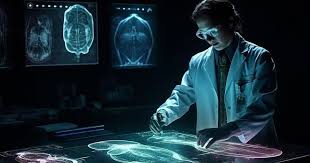AI Medical Imaging Solutions: Revolutionizing Healthcare Diagnostics
Artificial Intelligence (AI) is rapidly transforming various sectors, and healthcare is one of the most impacted. Among the many applications of AI in healthcare, AI medical imaging solutions stand out for their ability to improve diagnosis, reduce errors, and optimize workflows. These solutions use machine learning algorithms, deep learning, and computer vision to interpret medical images such as X-rays, MRIs, CT scans, and ultrasounds—helping radiologists and doctors diagnose diseases faster and more accurately.
What is AI in Medical Imaging?
AI in medical imaging refers to the use of artificial intelligence algorithms to interpret and analyze digital medical images. These tools assist radiologists in identifying abnormalities, measuring changes over time, and making diagnoses based on data-driven insights.
Common Technologies Used:
-
Deep Learning: Neural networks trained to recognize patterns in images.
-
Computer Vision: Algorithms to process, analyze, and understand visual data.
-
Natural Language Processing (NLP): Extracting information from radiology reports.
-
Predictive Analytics: Assessing risk and predicting outcomes.

How AI Improves Medical Imaging
1. Faster Diagnoses
AI systems can process thousands of images in seconds. For instance, during a pandemic or emergency, this rapid processing can help triage patients quickly.
2. Enhanced Accuracy
AI tools are trained on massive datasets, helping reduce human errors. Studies show that AI can detect conditions like breast cancer, lung nodules, and brain tumors with accuracy that rivals or exceeds radiologists.
3. Workflow Automation
AI automates routine tasks such as segmenting organs, measuring tumor sizes, or flagging anomalies. This allows radiologists to focus on complex cases.
4. Remote Diagnostics
AI imaging tools, when integrated with cloud systems, enable diagnosis in rural or underserved areas where radiologists are scarce.
Use Cases of AI Medical Imaging
Cancer Detection
AI can identify tumors in mammograms (breast cancer), CT scans (lung cancer), and MRIs (brain or prostate cancer). Tools like Google’s LYNA (Lymph Node Assistant) showed 99% accuracy in detecting metastatic breast cancer.
Stroke Diagnosis
Time is critical in stroke treatment. AI can identify ischemic and hemorrhagic strokes in CT images within minutes, aiding faster treatment decisions.
COVID-19 and Chest Imaging
AI systems were deployed to analyze chest X-rays and CT scans for signs of COVID-19 pneumonia, helping in fast screening during the pandemic.
Orthopedic Imaging
AI helps detect fractures, arthritis, and degenerative bone diseases in X-rays and MRIs with high precision.
Ophthalmology
AI tools like IDx-DR are FDA-approved for detecting diabetic retinopathy from retinal images without a doctor’s interpretation.
Top AI Medical Imaging Platforms
Here’s a look at one of the most well-known AI imaging platforms currently in use:
Aidoc – Leading AI Medical Imaging Solution
Aidoc is an AI-powered radiology platform that assists in detecting acute abnormalities across multiple body systems. It’s FDA-cleared and used globally in hospitals.
-
Features:
-
Real-time triage of critical cases (like brain hemorrhages).
-
Integration with existing PACS/RIS systems.
-
Workflow optimization.
-
Multimodality support (CT, MRI, X-ray).
-
-
Benefits:
-
Reduces radiologist workload.
-
Accelerates diagnosis and treatment.
-
Improves patient outcomes.
-
Official Website: https://www.aidoc.com
Other platforms include:
-
Zebra Medical Vision: Population health analytics.
-
Qure.ai: AI for chest X-rays and brain CTs.
-
Viz.ai: Stroke detection and coordination.
-
Lunit INSIGHT: Cancer diagnostics for breast and chest imaging.
Market Trends and Adoption
The global AI in medical imaging market is expected to exceed $10 billion by 2030, growing at a CAGR of 30%+. Factors driving growth:
-
Increased imaging data volume.
-
Radiologist shortages.
-
Need for faster diagnosis.
-
Regulatory approvals and real-world success.
Example: FDA Approvals
More than 100 AI-based imaging tools have received FDA clearance, indicating increasing trust and clinical validation.
Challenges and Limitations
Despite its potential, AI in medical imaging faces several hurdles:
1. Data Privacy
Medical images contain sensitive data. Ensuring HIPAA/GDPR compliance in AI training and processing is vital.
2. Bias and Generalization
AI models trained on limited datasets may not generalize well across populations, leading to biased predictions.
3. Integration Complexity
Integrating AI tools with legacy hospital systems (like PACS) requires investment and training.
4. Regulatory Compliance
Each tool must undergo rigorous testing and receive regulatory approval before clinical deployment.
Future of AI in Medical Imaging
The future promises:
-
Explainable AI (XAI): Tools that explain how they reach conclusions, increasing clinician trust.
-
Federated Learning: Training AI models without centralizing patient data.
-
Multi-modal AI: Combining imaging with lab data, genomics, and EHRs for holistic diagnostics.

Hospitals Using AI Imaging Today
-
Mayo Clinic – Uses AI for cardiovascular imaging and stroke detection.
-
Mount Sinai Health System – AI for chest X-rays and COVID-19 diagnosis.
-
NHS (UK) – Early cancer detection with AI support.
-
Apollo Hospitals (India) – Integrates AI to analyze CT scans and X-rays.
Conclusion
AI medical imaging solutions are revolutionizing the way diseases are diagnosed and managed. They offer speed, accuracy, and scalability—vital elements in modern healthcare. While challenges remain in adoption and integration, the trajectory is clear: AI is not replacing radiologists but empowering them.
As technology matures, these tools will become standard across hospitals worldwide, democratizing healthcare and saving lives.
Explore AI Medical Imaging in Action:
👉 https://www.aidoc.com
If you want tailored articles on specific AI platforms (e.g., Qure.ai, Viz.ai) or focus areas like oncology, neurology, or cardiology imaging, let me know!






